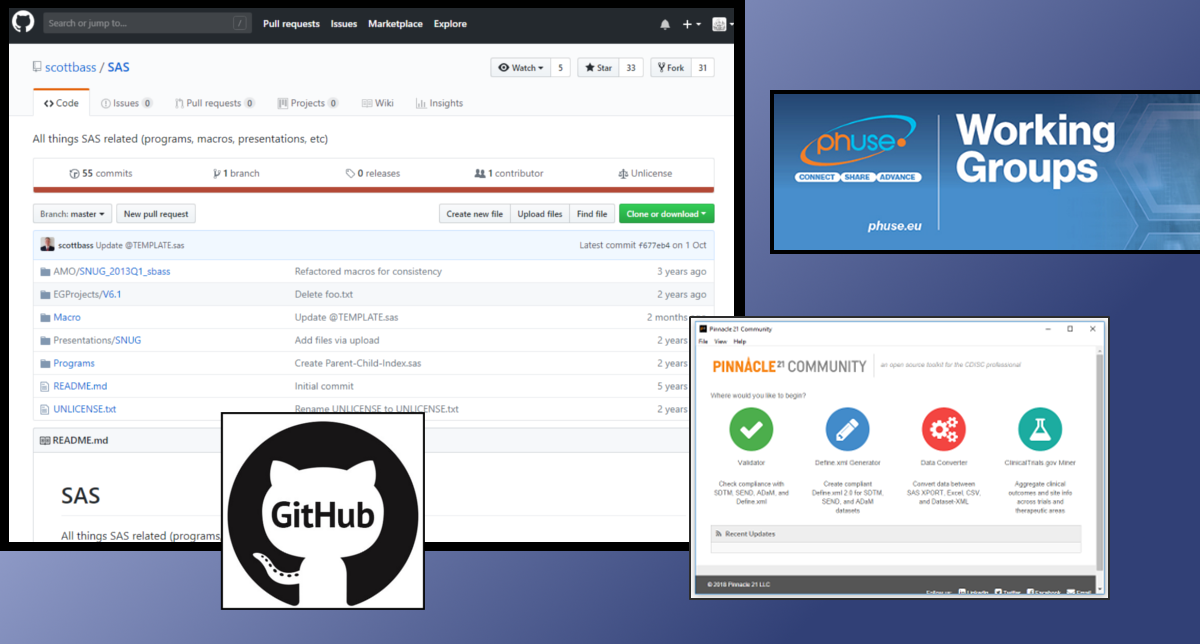Articles
Open Source in Clinical Study Evaluations (2018-12-14)

There are many advantages of having open source solutions available, particularly for industries where the main focus is not programming, but science. However, in clinical study evaluations there are just a very few open source programs available. Why? Where are the advantages? And what are the risks in our industry? This article will give you a short introduction and hopefully make you think about how we can go forward with open source.
Too long to read? Here is a 7 minute video with the content.
Pinnacle21 Community as Open Source Example
The "Pinnacle21 Community" tool – starting as OpenCDISC Validator – is a good example for an open source project. A great tool kit has been developed and used throughout the industry. It quickly became very famous and is now an important standard tool which is strongly recommended to use – and in case of PMDA even required.
As the popularity grew, more user requirements raised and funding has become more and more a topic. An enterprise version had been developed to be able to scope with all challenges. Nowadays Pinnacle21 is a very well running company. A blog about the history of OpenCDISC is available on their website.
Despite this story of success there are many critics around this tool kit. But why? The focus on commercializing the enterprise version seems to spoil the open source edition driving it almost into a neglected project. An enterprise version can of course have additional functionality, but missing out some core functionalities or even thinking about removing options from the open version is difficult to handle. Fortunately, at least some important functionality enhancements will be made available in the community version 3.0 which should be released soon.
Pinnacle21 has a monopoly position here. A complete industry relies on this tool for validation checks. Commercially it does not make sense to create a product in this area, as the core functionality is available for free in the community version and the investment for something similar would be much too high. Due to the license, a reuse is not possible. And missing competitions always results in issues and critics.
Lessons learned
So, what can our industry learn from this? First of all, open source projects have typically to cope with issues regarding funding. Everyone likes to have tools available for free, but somehow these must also be funded. And depending on the license you can either stimulate or prevent competition. From the customers a competition is highly appreciated, but for service providers these competitions mean risks and would normally better avoided.
Ways to go with Collaborations

First of all, the companies have to decide how open they would like to be. There exist many open collaborations. Most of them driven by the PhUSE which is a community consisting of those colleagues working in clinical study evaluations and related areas. The PhUSE provides collaboration platforms for many working groups. One of those is specifically concentrating on "Standard Analyses & Code Sharing". Unfortunately, the results did not meet the high expectations in this area, yet.
On the other hand, there are of course close collaborations where something is developed with just a few members. And finally, there are closed collaborations available with multiple companies where things are shared just within the membership.
Ideally collaborations should be open to support the complete industry as well as academia. Especially programs, tools and processes should be shared to be able to find best collaborative solutions which enables transparency and standardization also in the programming area of clinical study evaluations.
Why just few open sources?
What are the reasons why there are just a few open source programs and projects available? The area of clinical study evaluations is a very specific area with high regulations and long-term players on the marked. Typically, large companies have their own solutions available. They do not have an advantage of giving this away. Tools do not only consist of the programs itself, but also require documentation, training and validation. Who should provide all the required information? Putting a tool online is likely not sufficient.
Why are there no engaged people putting things together for free like what we see in other technological ecosystems? My guess is this is highly related to the purpose of clinical study evaluations. Only companies – typically large Pharma companies – would benefit from such open source projects. And as mentioned before, putting source and tools together for clinical study evaluations is not sufficient. Looking into the life cycle of tools in this area, in my experience less than 10% of the effort is going into the development part. The remaining 90% serves documentation, validation and provision of training – not to mention the important maintenance when updates are required or even bugs appear. There are hardly many people volunteering to perform these 90% for free.
Funding to get Open Source

A possible solution could be funding projects which are made available as open source. The question is whether companies see value in funding such projects and whether there are companies or persons who will provide their tools and programs as open source.
The most important factor for companies funding open source is the benefit. What would they gain? Or do they just have to pay so their competitors get the same solution for free? The more funding companies are supporting a project, the less expensive it will be for each one of them. But more stakeholders mean higher complexity as more communication and negotiation is required.
The main advantage for the funding company would be that they are involved in defining the project scope, content and direction. They are most likely the first testers and have direct influence on the development. Furthermore, they could even decide which parts will be made available as open source. Not necessarily everything needs to be made available. Extended documentation, training and validation could be kept in the project and available just for membership. Funders might even agree on a regular membership fee which could be made fixed to ensure further development, availability for updates and questions – especially urgent authority questions – at constant costs. In such a case competitors and academia could use the programs and tools, but for extended services, they can join through membership.
When the programs and tools are made available completely free also for commercial content, e.g. with the MIT license, then other companies could use this work and provide nice user interface or combine the solution in their own tools. A monopoly could be avoided. Of course, there is the risk that someone takes the programs and tools and create own services like extended documentation, validation and so forth. But is this a really a risk or just an opportunity? More competition means more solutions to choose from. Actually, this is something we strongly need in our industry. Currently many areas have just too few or no solutions available.
Starting Small, then Growing
There are many areas where solutions would be required in the clinical study evaluation area. Starting with a huge project scope would by risky, but a small project could prove how things are working and whether the benefits are worth the costs. So why not starting with a small project which has the option to start small and grow huge? It can simply be performed by a consultant which typically has no high costs.
I would be happy to perform open source projects. If you would like more information, please get in touch with me.
Why does license matter?
The license behind open source projects is very important. In the pharmaceutical industry many tasks are done by supporting specialized companies. As they have a commercial interest in using these tools, a commercial usage should be granted. Ideally also other tools should be allowed to be created based on open programs and tools. This is also only possible, when commercial usage is allowed. For this the PhUSE source is published under the MIT license. This should also be used for other open source projects.
Available Open Source on Github
Some companies provide already some tools and programs as open source in the field of clinical study evaluations. Rho Inc. for example hosts some projects on github. Roche share some R Projects on their github and are probably planning for more. You can also find some SAS macro repositories which use an open license for example this one from Scott Bass contains many useful SAS macros. If you know other related open source projects, especially with the programming language SAS, please let me know through linkedIn or differently. R has quite a lot available, CRAN lists on this website many. I also want to mention SASUnit as a validation framework for SAS which uses the GNU license.
Summary
Funded open source with no license restrictions is a chance for our industry to have better programs and tools available to build the ground for standardization in the programming field. We do not want monopoly, but memberships could be integrated to support funding rationales.
If you have enough internal resources, join and support working groups. If not, think about funding open projects. Collaboration is the best way going forward in supporting standard programming and processing to be able to face the challenges of the future which needs continuous update and change.
About the Author
Katja Glaß has IT background and is for more than 15 years in the pharmaceutical industry. She is now working as part-time consultant focusing on open source for Pharma, hosting a portal about open-source solutions for clinical study evaluations. She has key experiences with SAS, Web Technologies, ADAM, Define.xml and the TLF generation. She is a very active PHUSE member where she led the EU Connect conference in 2018. In 2021 she became board member of COSA to support this initiative as well.
